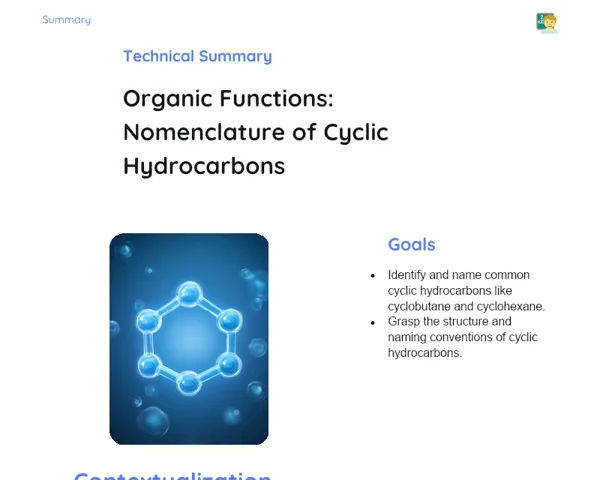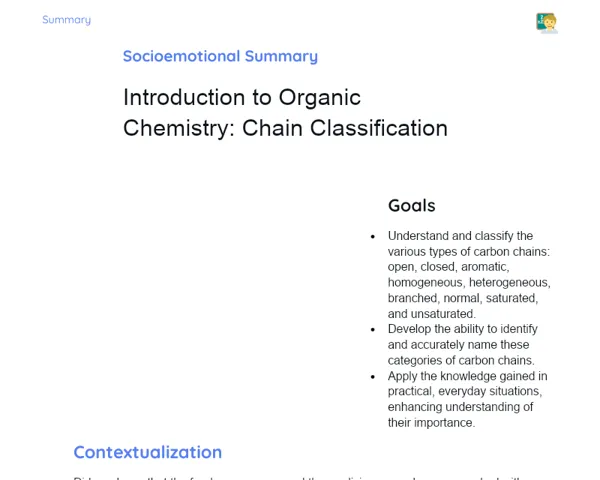Goals
1. Recognize organic compounds as acids or bases based on their chemical structures.
2. Rank organic compounds by their acidity and basicity, utilizing concepts from organic chemistry.
3. Grasp the connection between molecular structure and acid-base characteristics.
Contextualization
Organic compounds are present in many products we encounter daily, such as medicines, food items, and cleaning materials. Gaining insight into the acid-base properties of these compounds is crucial across various sectors, including the pharmaceutical industry, where the pH can affect the efficacy of a medicine, and environmental chemistry, which assesses how acidity impacts water and soil health. By studying these properties, we can create better products and address environmental challenges. For example, vinegar's acidity comes from acetic acid, a type of organic compound, whereas caffeine, commonly found in tea and coffee, acts as a weak base.
Subject Relevance
To Remember!
Definition of Acidity and Basicity in Organic Compounds
Acidity and basicity are fundamental chemical properties that dictate how a substance behaves in water. In organic compounds, acidity refers to the ability to give away a proton (H+), whereas basicity pertains to the ability to accept a proton.
-
Acidity: The capacity of a compound to donate a proton (H+).
-
Basicity: The capacity of a compound to accept a proton (H+).
-
Importance: Essential for understanding chemical reactions and behaviors in solutions.
Molecular Structure and Its Influence on Acidity or Basicity
The molecular structure of organic compounds, including various functional groups, significantly affects their acid-base properties. Groups like carboxylic acids tend to increase acidity, while amino groups augment basicity.
-
Carboxylic Groups: Enhance the acidity of compounds.
-
Amino Groups: Boost the basicity of compounds.
-
Relevance: The molecular structure determines how compounds behave in various environments.
Comparison of Different Organic Compounds in Terms of Acidity and Basicity
Evaluating different organic compounds helps in not only understanding their acid-base properties but also practical applications. Generally, carboxylic acids are more acidic than alcohols and phenols, while amines are recognized as weak bases.
-
Carboxylic Acids: More acidic compared to alcohols and phenols.
-
Amines: Classified as weak bases but more basic than alcohols.
-
Application: Needed for the appropriate classification and use of compounds in various industries.
Practical Applications
-
Drug development: Understanding acidity and basicity aids in the absorption and effectiveness of medications.
-
Food preservation: Managing acidity is key to curtailing spoilage and prolonging the lifespan of food items.
-
Industrial waste treatment: Monitoring acidity is crucial to neutralize harmful substances and safeguard the environment.
Key Terms
-
Acidity: The ability of a compound to donate a proton (H+).
-
Basicity: The ability of a compound to accept a proton (H+).
-
Functional Group: A collection of atoms within a molecule responsible for its characteristic chemical reactions.
-
pH Indicator: A substance that changes color in accordance with the pH of a solution, utilized to gauge acidity or basicity.
Questions for Reflections
-
How does the molecular structure of organic compounds impact their acid-base properties?
-
In which real-life scenarios can the acidity or basicity of an organic compound be critical?
-
What environmental challenges can arise from the imbalance of acidity in water and soil?
Practical Challenge: Testing Acidity and Basicity
In this challenge, you will investigate the acidity and basicity of various organic compounds commonly found at home using simple pH indicators.
Instructions
-
Collect samples of usual household products you think may be acidic or basic (like lemon juice, vinegar, baking soda, or soap).
-
Prepare small containers for each of these samples.
-
Use litmus paper or another accessible pH indicator to test the acidity or basicity of each sample.
-
Take note of the results and analyze the acidity and basicity of the tested compounds.
-
Organize the compounds based on their acidity and basicity from your results.



